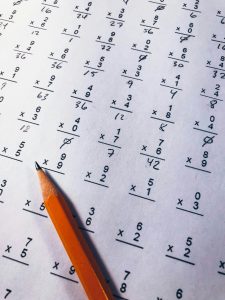Collaborative Math Puzzles: Unlocking the Power of Teamwork in Learning

Introduction
Are you a parent concerned about your child’s struggles with mathematics? Do you wish there were a way to make math more engaging and help your child develop essential skills beyond just numbers? Look no further! Collaborative math puzzles are here to unlock the power of teamwork in learning and transform your child’s mathematical journey. In this article, we will explore the benefits of collaborative learning, share practical tips on implementing collaborative math puzzles, and delve into the fascinating world of abacus-based mathematics. Let’s dive in!
What is Collaborative Learning?
Collaborative learning is an educational approach that emphasizes group work and interaction among students. It involves sharing ideas, solving problems, and working towards a common goal as a team. In the context of mathematics, collaborative learning encourages students to engage in discussions, explore various problem-solving strategies, and gain a deeper understanding of mathematical concepts through peer interaction. By fostering an environment of active participation and cooperation, collaborative learning creates an exciting space where students can thrive.
Examples of Collaborative Math Puzzles and Activities
|
Puzzle/Activity Name |
Description |
Skills Developed |
Suggested Age/Grade |
|---|---|---|---|
|
Fraction Comparison Challenge |
Groups receive different fraction scenarios to solve and discuss before agreeing on answers. |
Reasoning, consensus-building |
Middle School |
|
Operation Math Relay |
Teams solve a series of puzzles requiring different operations (add, subtract, multiply, divide). |
Arithmetic, quick thinking |
Grades 4+ |
|
Make-A-Ten Go Fish |
Students play a card game in teams to find pairs that sum to ten. |
Number sense, cooperation |
Early Grades |
|
Tic-Tac-Toe Math |
Teams play tic-tac-toe, answering math questions to claim squares. |
Review, strategy, teamwork |
All Grades |
|
Tower of Hanoi |
Teams work together to solve this classic logic puzzle, planning moves and discussing strategy. |
Logical reasoning, planning |
All Grades |
|
Sudoku Group Challenge |
Students collaborate to solve a Sudoku puzzle, sharing strategies and checking each other’s work. |
Pattern recognition, communication |
Middle/High School |
|
Think-Pair-Share |
Students think individually, discuss with a partner, then share with the group. |
Critical thinking, communication |
All Grades |
|
Math Jigsaw |
Each group solves a part of a larger problem, then teaches their section to the class. |
Accountability, synthesis |
All Grades |
|
Problem-Solving Games |
Teams tackle brain teasers and puzzles, competing or collaborating to find solutions. |
Creativity, teamwork, perseverance |
All Grades |
The Benefits of Collaborative Math Puzzles
Deeper Understanding Through Group Discussions
Collaborative math puzzles provide an excellent platform for group discussions, allowing students to expose themselves to diverse problem-solving strategies and perspectives. When students work together to solve challenging math problems, they naturally bring their unique approaches to the table. This exchange of ideas leads to a richer grasp of mathematical concepts as students learn from one another’s insights and thought processes.
Increased Engagement and Motivation
Solving math puzzles as a team transforms the learning experience from a solitary task to an exciting, interactive adventure. Students become more motivated and engaged, eagerly sharing their ideas and working cooperatively towards finding solutions. The sense of camaraderie within the group fosters a positive learning atmosphere, making math an enjoyable subject for every participant.
Enhanced Communication and Articulation Skills
Explaining solutions and reasoning to peers is an integral part of collaborative math puzzles. By articulating their mathematical ideas clearly, students develop robust communication skills. They learn to express their thoughts precisely and concisely, improving their ability to convey complex mathematical concepts in a coherent manner. These enhanced communication skills serve as valuable assets in both academic and real-life scenarios.
Teamwork and Responsibility
Collaborative math puzzles teach students the importance of shared responsibility, time management, and constructive conflict resolution. Each team member has a specific role to play, such as a recorder, presenter, or facilitator. Assigning these roles ensures accountability and active participation from every student. Additionally, through collaborative learning, students learn to value diverse perspectives, resolve differences amicably, and appreciate the power of teamwork.
Tips for Implementing Collaborative Math Puzzles
Clear Roles for Effective Collaboration
Assigning specific roles within the collaborative group is crucial for effective teamwork. Designate a recorder to document ideas and solutions, a presenter to communicate findings to the class, and a facilitator to ensure everyone’s voices are heard and discussions stay on track. Clear roles promote accountability and ensure every student actively contributes to the collaborative learning process.
Individual Thinking First
Before diving into group discussions, encourage students to attempt the math puzzles individually. This individual thinking time allows students to build their confidence, develop unique insights, and explore different problem-solving approaches. Afterwards, when they come together as a team, they can share their ideas and learn from one another’s perspectives.
Open Communication and Respectful Discussions
Foster an environment where all ideas are valued and discussions are respectful. Encourage students to listen actively, ask questions, seek clarification, and provide constructive feedback to their peers. Emphasize the importance of respecting different viewpoints, promoting inclusivity, and creating a safe space for open communication.
Variety of Activities for Continued Engagement
To sustain student engagement, incorporate a variety of collaborative math puzzles into your lessons. Rotate the types of puzzles and the groupings of students to expose them to different peer perspectives. This variety keeps the learning experience fresh and exciting while encouraging students to adapt their problem-solving strategies based on the puzzle at hand.
The Abacus Advantage in Collaborative Math Learning
Abacus: A Powerful Tool for Mental Math
The abacus is a centuries-old tool that has proven its efficacy in teaching mental math skills. It serves as a visual aid, helping students visualize numbers and perform calculations quickly in their minds. By incorporating the abacus into collaborative math puzzles, students can enhance their mental math abilities while working collaboratively with their peers.
Abacus-Based Programs and Skill Development
Abacus-based programs, such as those offered by SIP Abacus, provide structured modules that gradually develop students’ mental math skills. These programs cater to different skill levels, ensuring that every student receives personalized attention and instruction tailored to their needs. The curriculum combines the use of the abacus with visualization techniques, fostering a deeper understanding of mathematical concepts and promoting collaborative learning.
Cognitive Development and Overall Growth
Studies have shown that students who participate in abacus-based programs exhibit significant improvements in cognitive development, including enhanced focus, concentration, and attention span. The unique approach of using the abacus stimulates both sides of the brain, nurturing students’ academic growth and overall intelligence. Additionally, students develop skills such as visual memory, retention, speed writing, and numerical ability through these programs.
Summing Up
Collaborative math puzzles have the power to revolutionize your child’s mathematical journey. By actively engaging in group discussions, sharing ideas, and working towards a common goal, students develop a deeper understanding of mathematical concepts while honing essential communication and problem-solving skills. When combined with abacus-based programs like those offered by SIP Abacus, collaborative math learning becomes even more effective. Students not only improve their mathematical abilities but also experience overall cognitive development and enhanced academic performance. So why wait? Embrace the power of collaborative learning today, and watch your child thrive in the world of mathematics!



